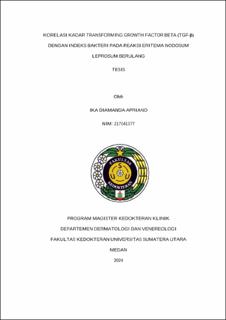| dc.contributor.advisor | Lubis, Ramona Dumasari | |
| dc.contributor.advisor | Nadeak, Kristina | |
| dc.contributor.author | Apriano, Ika Diamanda | |
| dc.date.accessioned | 2024-07-31T03:34:27Z | |
| dc.date.available | 2024-07-31T03:34:27Z | |
| dc.date.issued | 2024 | |
| dc.identifier.uri | https://repositori.usu.ac.id/handle/123456789/94604 | |
| dc.description.abstract | Introduction : Leprosy is a chronic granulomatous infection caused by infections
of Mycobacterium leprae and Mycobacterium lepromatosis. Erythema nodosum
leprosum (ENL) is an immunological complication of leprosy due to a type III
hypersensitivity reaction. Recurrent ENL reaction was defined as the occurrence of
a second or more episode of ENL reaction after 28 days of the end of the previous
treatment. Transforming growth factor beta (TGF-β) is a suppressor cytokine that
can inhibit the work of macrophages and caused increased of bacterial proliferation.
TGF-β levels and bacterial index have been shown to have an important relationship
in the pathogenesis of ENL reactions.
Subjects and Methods: Observational analytical study with a cross-sectional
approach on 31 subjects aged ≥18 years with recurrent type 2 leprosy reactions.
Basic data recording and subject examination included calculating the bacterial
index of leprosy patients using a slit skin smear to measure TGF-β levels. The
correlation between TGF-β and the bacterial index was analyzed using the
Spearman correlation test.
Results: There was a weak negative correlation between TGF-β levels and bacterial
index in recurrent ENL sunjects (p=<0.05, r=-0.390). The majority of recurrent
ENL subjects were aged 18–25 years and 26–35 years, 10 patients each (32,3%),
male gender, 21 patients (67,7%), highest level of education was secondary
education, 26 patients (83,9%) and more did not work as many as 20 patients
(64,5%). Most of the research subjects experienced recurrent ENL reactions during
MDT as many as 21 patients (67,7%), with majority of subjects have BI +2 wich is
10 patients (32,2%), and the mean value of TGF- β levels in all subjects was 305.12
± 45.77.
Conclusion: There is a weak negative correlation between TGF-β levels and the
bacterial index in recurrent ENL patients. | en_US |
| dc.language.iso | id | en_US |
| dc.publisher | Universitas Sumatera Utara | en_US |
| dc.subject | Transforming growth factor beta | en_US |
| dc.subject | erythema nodosum leprosum | en_US |
| dc.subject | reccurent erythema nodosum leprosum | en_US |
| dc.subject | bacterial index | en_US |
| dc.subject | leprosy reaction | en_US |
| dc.subject | SDGs | en_US |
| dc.title | Korelasi Kadar Transforming Growth Factor Beta (TGF-β) dengan Indeks Bakteri pada Reaksi Eritema Nodosum Leprosum Berulang | en_US |
| dc.title.alternative | Correlation of Transforming Growth Factor Beta (TGF-β) Levels with Bacterial Index on Recurrent Erythema Nodosum Leprosum Reactions | en_US |
| dc.type | Thesis | en_US |
| dc.identifier.nim | NIM217041077 | |
| dc.identifier.nidn | NIDN0004107203 | |
| dc.identifier.kodeprodi | KODEPRODI11103#Ilmu Kedokteran Klinis | |
| dc.description.pages | 117 Pages | en_US |
| dc.description.type | Tesis Magister | en_US |


